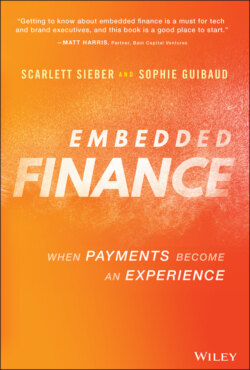Читать книгу Embedded Finance - Scarlett Sieber - Страница 7
CHAPTER ONE THE NEXT FINANCIAL REVOLUTION
ОглавлениеGo back for a moment to the early 2000s and imagine hearing about a new phone concept that was going to be more than a phone. In fact, it was actually a mini-computer with most of the screen as glass. That concept would have seemed unbelievable at the time but of course we know now that the concept was the first iPhone. The story we are about to tell about another new concept is as exciting as that and will arguably have an even larger impact. This is the story about embedded finance. It's about a revolution in how people live, interact with, and manage their money.
The early versions of it are already here, whether you realize it or not. Embedded finance is changing how every company in the world, from the largest bank and tech company to the smallest mom and pop shop, does business and how they engage with you.
Part of the history of financial services is the separate but related story of financial technology, popularly known as fintech. Fintech emerged from a crisis in banking and delivered a smoother customer-centric experience with less friction. Have you sent money to a friend via Venmo, Zelle, CashApp, or another app? You were utilizing fintech. Have you used your phone or a tap of your card to pay for your groceries? You were utilizing fintech. What about opening up an account to directly invest in the market yourself through Robinhood, Acorns, or Public? You were utilizing fintech.
How did this technology transform banking, and who were the companies and entrepreneurs to make it happen? How did fintech change consumer expectations, and what impact did this have on banks’ strategies? These are all critical questions, because they were the basis of fintech, and fintech is the foundation for embedded finance. Fintech brought banks and technology companies together in order to create new products and serve the digital-centric customer. As we will see throughout this book, embedded finance completes the journey fintech started.
The embedded finance revolution is fundamentally about the seamless movement of money that keeps our society functioning. The friction, the barriers that slow it down, are disappearing. Everyone knows that in most cases, we no longer have to wait in line at a bank branch to complete basic transactions. You can do all (or most of) your transactions from the comfort of your home through your phone or your computer. But it's getting even easier than that. Your money—or rather, your access to your money—is everywhere. It appears when needed at every point of context, instantly and transparently. It's a natural evolution powered by genuine consumer need, enabled by technology. This is a cool concept, but what does this look like in practice?
Today this takes the form of loans at the point of purchase, enabling you to finance a flat tire, or home insurance that appears alongside your new rental agreement. The companies we deal with every day can offer us financial services exactly when we need them, and often we don't need to do anything further, just agree to it. The services, informed by data and powered by machine learning, are optimized for us and are up and running in minutes, sometimes even in seconds.
We call this “embedded finance” because the finance is embedded in another context—a checkout line, a mobile app, etc. From the consumer perspective, it could be summarized as “invisible payments” or “invisible finance,” because the key message is that the financial transaction becomes naturally integrated into what you are doing to the point it feels invisible.
Embedded finance is different because it enables companies across industries, with existing audiences, to cater to their customers’ financial needs at the point of context. It is an enabler of new revenue streams, stronger customer engagement, and better visibility and access to key pieces of data. Most importantly, it equips technology companies, brands, and retailers with the ability to provide a banking and payments experience to their customers in a seamless, convenient, and authentic way by providing financial services when they need it most, naturally integrated into the experience.
Those of us who have ever gone to a car dealership and explored the option of purchasing a car (new or used) will be familiar with car dealers offering loans on cars. The dealer is not making the loan himself, he is a conduit for the loan, which is made by a bank or a captive finance company affiliated with an automotive manufacturer. The dealership is not offering finance as an act of charity. Without it, the dealer wouldn't make the sale to you, and he earns a percentage of the money you pay for on the loan as well. This works for all sides though, because without the loan, you might not be able to buy the car.
Another classic case of embedded finance in today's world is through Buy Now, Pay Later (BNPL), which happens at the point of sale. You are at an appliance store and want to purchase a $500 TV but only have $200 available to spend. The appliance store, typically backed by a network of partners, will front the money and you, the consumer, have a certain period of time to pay it back.
Buy Now, Pay Later is experiencing a tremendous renaissance today. A recent study from the financial marketplace LendingTree notes that 33% of consumers have tried BNPL and 67% of them plan on continuing to use it.1 Later in this book, we will explore the reasons behind this trend, and the companies and factors driving it.
